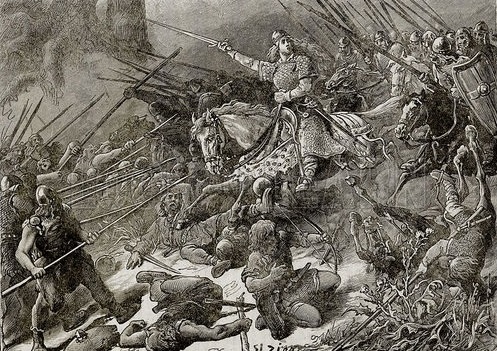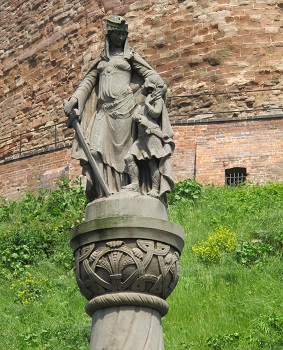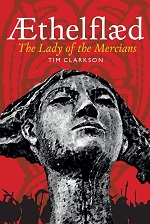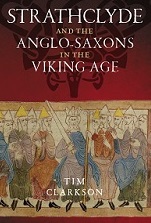
Aethelflaed leading her warriors into battle (from Cassel’s Illustrated History of England).
‘Certainly I think we could say that Mercia by the tenth century was prepared to accept female rulership in a way unlike any other part of early medieval Europe.’
The above quote is from a response by Jonathan Jarrett at his blog A Corner of Tenth-Century Europe. It appears in the comments thread attached to a recent post on the St Andrews Sarcophagus which considers the monument’s possible links with Anglo-Saxon sculpture. What Jonathan is referring to here is a brief period in the early 900s during which the Mercians – the people of the English midlands – were ruled by a woman. Her name was Aethelflaed and she is one of the most significant political figures of the Viking Age.
Aethelflaed was the firstborn child of Alfred the Great, king of Wessex, and sister of Alfred’s son and successor Edward (known as ‘the Elder’). She was born c.870, at a time when Wessex was under attack by Danish Vikings who had already ravaged and occupied East Anglia and eastern Mercia. Around 885 she became the wife of Aethelred, ruler of the still-unconquered western part of Mercia. Although Aethelred’s power was essentially that of a king, contemporary chroniclers referred to him as an ealdorman or senior lord. His marriage to Alfred’s teenage daughter cemented an alliance between Mercia and Wessex which brought the two realms closer together, thus laying the foundations of a unified English kingdom.
After Alfred’s death in 899, his son Edward succeeded to the kingship of Wessex and continued the struggle against the Vikings. Edward’s military policies relied on close co-operation with the rulers of Mercia – his sister Aethelflaed and brother-in-law Aethelred. After Aethelred’s death in 911, possibly from wounds inflicted in battle, Aethelflaed became sole ruler of her husband’s people. Her title, according to the contemporary Anglo-Saxon Chronicle, was myrcna hlaefdige, ‘Lady of the Mercians’. She proved herself a competent war-leader, forging a fearsome reputation in victories over Viking and Welsh foes. Campaigning beyond her eastern border she regained many of Mercia’s lost territories by wresting them out of Danish hands. Her greatest success came in 917 when she recaptured the stronghold of Derby, forcing its Danish occupants to submit to her rule. Her military policy also included the construction of new fortresses, as a protective shield against future incursions. One of these was at Tamworth, the ancient capital of Mercian kings.

Tamworth Castle.
I visited Tamworth earlier this year, to see the medieval castle which reputedly stands on the site of Aethelflaed’s fortress. Near the base of the castle’s mound is a statue of the Lady of the Mercians, mounted on a high pillar. It was erected in 1913 to mark the millennium of the fortress. In recognition of her military achievements the sculptor has depicted Aethelflaed holding a drawn sword. At her side stands a small child: her nephew Athelstan, the future king of Wessex, whom she fostered at her court.

My interest in Aethelflaed’s story began many years ago, when I was gathering information on Aethelburh, a queen of Wessex who lived in the eighth century. This was for an entry in Amazons to Fighter Pilots, an encyclopedia of female participation in warfare, which was published in 2003. As well as my brief note on Aethelburh (of whom little is known) the encyclopedia included an entry for Aethelflaed. At the time, I noted a number of similarities between these two Anglo-Saxon women, both of whom led armies to war in an era when such responsibilities were usually regarded as a male preserve. This prompted me to learn more about Aethelflaed and, in particular, to study her dealings with the kingdoms of North Britain whose history has always been my main area of research. Her contact with the northern realms is described in an Irish chronicle known as the ‘Fragmentary Annals’, which tells of a military alliance she forged in 918 with the kings of Alba and Strathclyde. Under the terms of this three-way pact, the Scots and Britons pledged to help Mercia if it was attacked by Vikings. The Irish annalist tells us that Aethelflaed gave similar pledges in return, ‘so that whenever the same race should come to attack her, they would rise to help her. If it were against them that they came, she would take arms with them’.
I discuss this alliance briefly in The Men of the North: the Britons of Southern Scotland, but my new book Strathclyde and the Anglo-Saxons in the Viking Age offered scope for a more detailed study. Aethelflaed duly features as an important figure in the fourth chapter, ‘Strathclyde and Wessex’, which covers the reign of her brother Edward the Elder (899 to 924). A photograph of her statue at Tamworth appears as a full-page illustration in the plate section in the middle of the book.

During my visit to Tamworth I purchased a booklet on the town’s Anglo-Saxon history. It was published by the local council in 2011 and was on display in the gift shop at the castle. The author, Stephen Pollington, has written several books on similar topics, including a comprehensive study of Anglo-Saxon warfare. His Tamworth booklet is concise, informative and well-illustrated. It has plenty to say about Aethelflaed and her military achievements and gives a dramatic account of her capture of Derby in 917. I especially enjoyed the following passage, which narrates the surrender of the Danish leader or ‘jarl’:
‘Finally, in a desperate attempt to get away from the massacre, the jarl called out to seek terms from the English commander. A group of horsemen rode through the gate, armoured in mail and with their tall spears sparkling. Behind them came a woman of no great age, her strong face framed by tightly-bound hair, dressed as if for a pleasant day’s riding in the woods. The jarl’s face reddened and he let out a roar of anger and humiliation as he realised from the deference of the warriors around her that this Englishwoman was the commander who had beaten him.’
Within a year of her great victory, Aethelflaed’s remarkable story came to an end. In June 918, King Edward of Wessex was at Stamford, a former Danish stronghold in what is now Lincolnshire. The Anglo-Saxon Chronicle tells us what happened next:
‘While he stayed there, his sister Aethelflaed died at Tamworth, twelve nights before Midsummer. He rode to the fortress at Tamworth, and all the people in Mercia who had been under Aethelflaed’s rule turned to him.’
So passed the Lady of the Mercians. She was taken with reverence to Gloucester, to be laid to rest alongside her husband in St Oswald’s Priory, a church they had founded together in the early years of their marriage.
* * * * *
References:
Stephanie Hollis, ‘Aethelflaed’, pp.5-7 in Reina Pennington (ed.) Amazons to Fighter Pilots: a Biographical Dictionary of Military Women. Vol.1 (Westport, 2003)
Stephen Pollington, Tamworth: the Ancient Capital of Mercia (Tamworth, 2011)
Frederick Wainwright, ‘Aethelflaed, Lady of the Mercians’, pp.53-69 in P. Clemoes (ed.) The Anglo-Saxons (London, 1959)
Joan Radner (ed.) The Fragmentary Annals of Ireland (Dublin, 1978)
* Although this chronicle contains elements of saga, its account of Aethelflaed’s alliance with Strathclyde and Alba is regarded by many historians as a record of real events.
(Link) Jonathan Jarrett’s blogpost on the St Andrew’s Sarcophagus.
* * * * * * *





The first chapter of my Dying and Death in Later Anglo-Saxon England (Boydell, 2004) is a case study of Aethelflaed – you might be interested, Tim? I’ve also published two novels about her, as V M Whitworth.
LikeLike
Thanks for this. I’ve had your Boydell book on my reading list for a while but didn’t know about the Aethelflaed connection. Will hunt it down on my next library visit.
LikeLike
Have retweeted this – I am so very interested as my novel To Be A Queen tells her story; it’s a book I’ve wanted to write ever since I studied the period as an undergraduate. Lovely blog piece, thanks for posting it
LikeLike
Thanks for your comment, Annie, and for giving the post a shoutout on Twitter.
LikeLike
Hi Tim
Just followed you. My biography of Aethelflead is due for release on the 15th of May. I made quite extensive use of the Annals of Ireland, and Wainwright’s work in it, as well as many other sources.
You can click the link to my blog for more details about the book, or visit Amazon. If you want to know anything else, don’t hestitate to comment or message me.
LikeLike
Hi Joanna,
Many thanks for visiting my blog. I can’t wait to read your book, having spotted it some weeks ago while searching for the latest news on Aethelflaed. I plan to buy it as soon as it appears and will mention it here and on Twitter. Looking forward….
LikeLike